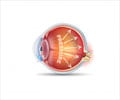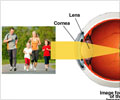A smart contact lens may help in predicting glaucoma progression and treatment evaluation.

- Glaucoma is the leading cause of blindness around the world.
- It is associated with raised intraocular pressure and optic nerve damage.
- A smart contact lens may be able to track the changes in intraocular pressure.
- The lens can help determine response to treatment and progression of the disease.
Forty patients with open angle glaucoma (most common type of glaucoma) between the age of 40 to 89 years were selected. Eight standard visual field tests were conducted on the patients over the course of two years and accordingly, patients were categorized into slow progression (20) and fast progression (20) categories. Thereafter, all the patients were made to wear Sensimed Triggerfish Sensor lenses all through the day and night. Electronic signals from the lenses were measured and it was observed that patients who recorded steep spikes overnight and a higher number of peaks overall, were the ones who belonged to fast disease progression group. This revealed that intraocular pressure-related parameters obtained over 24 hours with a contact lens sensor (CLS) were associated with the rate of visual field changes in glaucoma patients.
Intraocular Pressure (IOP) and Glaucoma
A fluid known as aqueous humor is continuously produced and circulated in the human eye. This fluid is responsible for maintaining the shape of the eye and providing nutrition to the lens and cornea as they do not have their own blood supply. This fluid drains out of the anterior chamber of the eye through a meshwork. In the case of a disruption of this outflow, pressure builds up within the eye.
The normal IOP is between 10 and 21 mm Hg. In most cases of glaucoma, the pressure is greater than 21 mm Hg.
How the Smart Lens Works?
As it was observed in the study, the patients with fast progressive disease showed greater spikes at night and overall higher number of peaks, the smart lens may help in quick identification of patients who are at higher risk of disease progression by mapping the fluctuations.
It can also help in evaluating whether the current treatment modality being used in a patient is showing the desired improvement or not and decision may be taken to continue or alter the regime.
C. Gustavo De Moraes, MD,MPH, the study author and professor at the Columbia University said, “This could be very useful if you want to know whether a new medication is working for a patient. You can see how their eye is reacting to the therapy in a much more meaningful way.’’
FDA Approval
FDA (Food and Drug Administration) has approved the marketing of the Triggerfish Sensor, as a device to be used for sensing the optimal time to check a patient’s intraocular pressure. It was allowed, as FDA found an effective correlation between the device’s output and fluctuations in intraocular pressure.
The approval is through the regulator’s de novo premarket review pathway, a pathway for certain low to moderate risk medical devices which are not equivalent to an already legally marketed device.
It has been emphasized that the device does not measure IOP and is not diagnostic in nature.
The device has only been approved for use in patients over 22 years of age under the supervision of a certified healthcare professional.
Certain side effects such as pressure marks from the lens, ocular hyperemia (redness of the eyes) and punctate keratitis (corneal irritation) were noted. These side effects are temporary in nature.
This is a major landmark in the treatment of glaucoma and promises hope that soon, the lens will be able to effectively monitor glaucoma patients and guide healthcare professionals in choosing treatment modalities according to the individual patient.
References
http://www.aao.org/eye-health/news/smart-contact-lens-glaucoma-patients
http://www.visionaware.org/blog/visionaware-blog/the-fda-approves-marketing-of-the-triggerfish-smart-contact-lens-sensor-to-monitor-glaucoma-eye-pressure-2338/12
Source-Medindia














